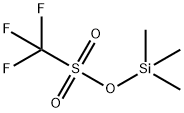Trimethylsilyl Trifluoromethane sulfonate is generally used following reactions:
1. Silylation. TMSOTf is widely used in the conversion of car bonyl compounds to their enol ethers. The conversion is some 109 faster with TMSOTf/triethylamine than with chlorotrimethy lsilane.Dicarbonyl compounds are converted to the corresponding bis enol ethers; this method is an improvement over the previous two step method.In general, TMSOTf has a tendency toC-silylation which is seen most clearly in the reaction of esters, whereC-silylation dominates over O-silylation.
2.Carbonyl Activation. 1,3-Dioxolanation of conjugated enals is facilitated by TMSOTf in the presence of 1,2-bis(trimethylsilyl oxy)ethane. In particular, highly selective protection of sterically differentiated ketones is possible (eq 10).TMSOTf mediates a stereoselective aldol-type condensation of silyl enol ethers and acetals (or orthoesters). The nonbasic reaction conditions are extremely mild. The use of TMSOTf in aldol reactions of silyl enol ethers and ketene acetals with aldehydes is ubiquitous. Stereoselective cyclization of α,β-unsaturated enamide esters is induced by TMSOTf and has been used as a route to quinolizidines and indolizidines.
3.The often difficult conjugate addition of alkynyl organometallic reagents to enones is greatly facilitated by TMSOTf. In particular, alkynyl zinc reagents (normally unreactive with α,β-unsaturated carbonyl compounds) add in good yield.The formation of nitrones by reaction of aldehydes and ketones with N-methyl-N,O-bis(trimethylsilyl)hydroxylamine is accelerated when TMSOTf is used as a catalyst; the acceleration is particularly pronounced when the carbonyl group is under a strong electronic influence.5. Methyl glucopyranosides and glycopyranosyl chlorides undergo allylation with allylsilanes under TMSOTf catalysis to give predominantly α-allylated carbohydrate analogs.Glycosidation is a reaction of massive importance and wide spread employment. TMSOTf activates many selective glycosidation reactions.
4.O-Silylation. The formation of TMS ethers can be achieved by reacting the requisite alcohol with TMSOTf and an amine (triethy lamine, pyridine, or 2,6-lutidine) in dichloromethane;C-Silylation. Depending on the reaction conditions, sec ondary amides can be either C-silylated or N-silylated;N-Silylation. The N-bis-silylation of α-amino acids with TMSOTf is only effective for glycine; for other α-amino acids N-mono-silylation prevails because the larger size of the carbon chain at the α-position hinders bis-silylation;C,O-Bis-silylation. Bis-silylation ofα,β-unsaturated carbonyl compounds can be achieved by palladium-TMSOTf-catalyzed addition of disilanes to enones, enals, or aromatic aldehydes via an η3-silyloxyallylpalladium intermediate;Carbonyl Activation. TMSOTf frequently acts as a Lewis acid and it is able to activate several functional groups (the car bonyl group, the acetal unit, the nitrone moiety,…) thus facilitating different kinds of reactions;Acetal Activation. TMSOTf acts as a catalyst for the addi tion of several nucleophiles (allylsilanes, allylstannanes, silyl enol ethers, trimethylsilyl cyanide) towardN,O-acetals;Nitrone Activation. The nucleophilic addition to aldonitrones depends on the nature of the metal involved and the presence/absence of an activator;Epoxide Ring Opening. One-pot alkylation-O-silylation re actions of epoxides take place in excellent yields;Cleavage of Protecting Groups. THP ethers of primary, sec ondary, and phenolic alcohols can be conveniently deprotected at room temperature; Hypervalent Iodine Chemistry. The formation of hyperva lent iodine complexes is often promoted by TMSOTf.







